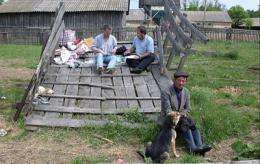Chernobyl radiation fells female birds, making chirping more frequent from lonely bachelors

Birdsong is one of the joys of nature, but higher percentages of birds chirping near Chernobyl are a perverse indication of radiation contamination, according to a new study.
An international team of researchers studied gender abundances and singing behavior in birds from eight areas with varying levels of radiation contamination near Chernobyl, Ukraine, the center of the catastrophe that began with an explosion in a nuclear power plant on April 26, 1986.
The results, published in PLoS One, were clear: higher levels of contamination went hand-in-hand with greater male-to-female ratios.
"We're seeing higher mortalities for females than males, reflecting the increased costs of reproduction in these stressful environments," said co-author Timothy Mousseau, a professor of biological sciences in the College of Arts and Sciences at the University of South Carolina. Male bird mortality also increased with background radiation levels, he added, but the female susceptibility to contamination was far stronger.
Counting the number of birds singing in each area, the researchers found that the percentage chirping was higher in the more contaminated areas. Given the relative dearth of females in those areas, the team concluded that lonely bachelors were spending more time calling out for mates.
That observation means that some earlier Chernobyl data might beg an even more stark interpretation. "When we did the original censuses, the standard method for doing a bird count is birds that you can either see or hear," Mousseau said. "So our early estimates of abundance were probably overestimates in the contaminated areas."
The data also showed higher percentages of yearlings, rather than more mature birds, in the areas of higher contamination.
"It's what we've seen for many years now," said Mousseau, the director of the Chernobyl Research Initiative at USC, which has sponsored studies on the long-term ecological and health consequences of the Chernobyl disaster since 1998, including many collaborations with this paper's co-author Anders Møller of the CNRS in France.
"Within the Chernobyl zone, it's very heterogeneous – where the contamination levels are high, there are far fewer birds."
The team captured and examined birds to determine their sex in regions with background radiation ranging from 0.02 to 138 micro-Sv per hour (0.02 to 0.05 micro-Sv per hour are normal background radiation levels in the northern Ukraine).
More information: PLoS ONE 7(4): e35223. doi:10.1371/journal.pone.0035223
Journal information: PLoS ONE
Provided by University of South Carolina
















